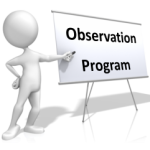What do I need to start an effective Observation program? (Observations, Part 4 of 4)
 The benefits of an observation program can provide a large return on investment (ROI) when done correctly. Depending on how comprehensive your program is, will determine how much it will cost software-wise, and how much maintenance the system will need to run. I have seen both simple and very complex programs, and each have their pros and cons. Whichever you choose to create or maintain, the following 5 elements sufficiently comprise an effective Observation program. Once you have your software working and your observers trained, your organization will be poised for improvement.
The benefits of an observation program can provide a large return on investment (ROI) when done correctly. Depending on how comprehensive your program is, will determine how much it will cost software-wise, and how much maintenance the system will need to run. I have seen both simple and very complex programs, and each have their pros and cons. Whichever you choose to create or maintain, the following 5 elements sufficiently comprise an effective Observation program. Once you have your software working and your observers trained, your organization will be poised for improvement.
Observation program elements:
1. Training developed and implemented to create an intrusive leadership team of observers. A key piece of Observation training (if you read the top white paper below, you'll see where this is supported) is to make sure it is not a one-shot-deal. At certain frequencies observers need to be reminded and to remind each other what an intrusive observation looks like. SOER 10-02, rec 2.b, Observation training could be the avenue for this. Experienced observers should focus on having a questioning attitude and maintaining alignment and consistency within the organization, while improving quality of comments when documenting performance. I like using real comments inputted from users in the program and then asking students how they would grade the behavior based on what it says. Among other things, this helps students become aligned with grading. I've shot some video this year on the person that consistently performs the most observations at the station, and the person who consistently is the most critical when documenting them. I also was able to get the Plant Manager to submit a video about what he expects from the leadership team in regards to the Observations program. These videos will be shown in future observation training classes.
2. The Database to track lessons learned from the observations will either be home grown, or if you have a budget you can buy some tweak-able tracking programs out of the box (i.e. ObservationWay, PsychSoft, IndustrySafe, etc.). The database acts as the foundation of the entire program.
3. Scorecards for particular activities. Scorecards contain area fundamentals (headers) and observable behaviors (attributes). Behaviors can have trend codes assigned to them for tracking and trending after the observation gets entered into the database. Scorecards can be developed for specific training types (i.e. classroom, OJT, TPE, etc), or different Industrial Safety (i.e. rigging and lifting, confined space, etc.) and for plenty of other unique situations. Cases have been made from both sides for having scorecards telling observers things to look for, or just showing up with an open mind (no particular plan), a pen and a notepad. I firmly attest to having a scorecard to remind you of specific things you should be looking for given the chosen situation.
4. Trending is performed from reports that scan completed scorecard fields and then put the information together in either a canned, or a user-defined format. The ability to do this well, will typically depend on how good your software works with your program, or how many worker-hours you spend mining the data (if your software is lame). When you trend the data, you should be able to find your top areas for improvement in a user-defined duration, and where your organization is uniquely performing well. The possibility exists that you can leverage what is being performed well into the areas needing improvement. Trending is where the proactive side of your Observation Program has the ability to feed into your reactive side, your Corrective Actions Program.
5. Indicators to track performance improvement or degradation are also a function of a well-run software program. I have directly experienced two home-grown databases (and ObservationWay) in the past 6 years, and I must admit, the software uniquely designed for this application (O-Way) is far better than anything home-grown. Indicators can track leadership accountability for who is performing observations, and who isn't. What you decide to measure is slave to the content of your database. Your program needs to go beyond who is doing them and the quality of them - it needs to explore what you are learning because of them, and giving that information back to the organization in the most useful way.
Observation Program Links:
Safety Observation Programs: How to Drive Insight from Observations
A PowerPoint on a Management Observation Program
White Paper Links:
Observation Methods for Human Performance TechnologyEPRI 2001 Final Report on Leading Indicators of Human Performance (This report went public in 2006)